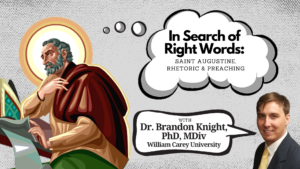 Column Title: In Search of Right Words: Saint Augustine, Rhetoric, and Preaching
Column Title: In Search of Right Words: Saint Augustine, Rhetoric, and Preaching
By Brandon Knight, Ph.D.
William Carey University
November: “The Death of the Soul”
Column Description here: Saint Augustine, Bishop of Hippo, in his work On Christian Doctrine, illustrates the important relationship between preaching and rhetoric. Even in his day, many questioned what use the church could possibly gain from the study of oratory. Nevertheless, Augustine saw something much deeper in communication that many Christians still miss centuries later. This column will be a personal journey through Augustine’s On Christian Doctrine, through which he shows how God can, in fact, use rhetoric to help us see more clearly the beauty of scripture as well as find the right words when articulating gospel truths to others.
February 2023 / November 2022 / October 2022 / July-August 2022 / June 2022 / April-May 2022 / February 2022 / January 2022 / December 2021
November 2022
“The Death of the Soul”
A common critique to biblical interpretation and preaching is that evangelicals interpret scripture primarily through biblical literalism.
In Marcus J. Borg’s Speaking Christian, he seeks to redeem contemporary Christian language from biblical literalism. Borg does so through heaven and hell distinctions. The heaven form of language is described as analogous and metaphorical uses of language. The hell form implies the literalization of language.[i]
Borg’s formulation of Christian language should be understood as a response to a hyper form of literalism that, in many ways, is detrimental to believer and seeker alike.
Pastors and Christian teachers can learn much about Christian language from Borg’s critique.
Although Borg’s Heaven and Hell dichotomy itself goes too far, his highlighting of the negative effects of hyper literalism is insightful.
Augustine, the fourth century bishop of Hippo, similarly argues in On Christian Doctrine that one’s desire for literalism should not overtake figurative texts in scripture. If done, he says, the result is deadly, figuratively speaking, even to the one interpreting.
“For when what is said figuratively is taken as if it were said literally, it is understood in a carnal manner. And nothing is more fittingly called the death of the soul than when that in it which raises it above the brutes, the intelligence namely, is put in subjection to the flesh by a blind adherence to the letter.”[ii]
To Augustine, this was a personal matter of discussion.
Prior to his conversion, Augustine’s search for truth took him to a religious group called Manicheanism. During that time, he found the Christian scriptures and its defenders to be too simplistic.[iii]
But with a twist of fate, many years later, Augustine found himself defending the once believed “simplistic” faith against the Manichee.
Specifically, in other works, the bishop recounts the Manichean critique of the Imago Dei, or the image of God, by lambasting early Christian literalists who questioned God’s physical body shape in relation to humans. Does God have teeth, hair, gender, etc.?
It is this very literalizing of figurative passages that Augustine calls the “death of the soul.”
Augustine’s teaching, however, is not a scorched earth approach toward literalism—unlike Borg’s. Rather it is about nuance. Figurative language need not be literalized because, when done, the meaning is clouded. Some of the ugliest Christian art has been an attempt to give aesthetic to the great glories of scripture.
Case in point:
The problem, again, is that literalism doesn’t give figurative language justice. Instead, one could argue it deadens the imagination and its richness.
Many parts of the Bible are figurative and therefore meant to be read and understood in non-literal ways.
The psalms, for instance, poetically express truths about God that go beyond the mere literal understanding. For instance, when the psalmist declares, “For you are my rock and my fortress; lead me and guide me for the sake of your name,” he is not literally saying that God is a big stone in the sky (Psalm 31:3 ESV). Rather, the use of figurative language pinpoints our ability to probe the depths of God by likening his characteristics to literal entities whose attributes are known. Thus, to the psalmist, God is akin to firm ground and a place of protection from harm.
Even Jesus’ religious contemporaries, at times, seemed dull to his more figurative statements. Take for example, Jesus’ statement about his “temple” being destroyed, but eligible to be rebuilt in three days.
Augustine’s attribution to this hermeneutical temptation as the “death of the soul” must not be taken lightly. Figurative language cannot be neglected. But, neither should literalism.
Life-Giving Literalism
So, yes, literalism is not the solution to every biblical passage because many passages are written figuratively. However, many parts of scripture are meant to be interpreted literally. Despite this fact, many Christians have sought to eradicate this possibility altogether.
For example, multiple Christian denominations attempt to only interpret the life, death, and resurrection of Christ figuratively. The historical importance is, as a result, left out and replaced by the metaphorical meaning which is obtained through the story’s contents and use of symbols.
What are we to make of this overreaction to biblical literalism?
Akin to hyper-literalism, anti-literalism is also damning. To deny the historical (i.e, literal) death and resurrection of Jesus of Nazarene is to ultimately reject the meaning only obtainable through the literal interpretation, namely that his death was a substitution in our stead.
If this did not literally occur, the apostle Paul says, “We are of all people the most to be pitied” (1 Cor. 15:19b ESV). There are many passages that use figurative language to make sense of what is to occur in the resurrection, but that should never dissolve our literal understanding that we too will rise one day with Christ. Rather, it should further enrich it.
Scripture and Christian symbols are rich with meaning. Faithful preachers and teachers of the word seek to be faithful with the nuance of Christian language and imagery.
Let’s interpret and use them correctly, lest we find ourselves at a place in the future in which our imaginations are deadened to the glories of the gospel truth, literally and figuratively speaking.
NOTES
[i] Marcus J. Borg, Speaking Christian: Why Christian Words Have Lost Their Meaning and Power, and How They Can Be Restored (HarperOne, 2012).
[ii] “St. Augustine: On Christian Doctrine, in Four Books – Christian Classics Ethereal Library,” accessed November 21, 2022, https://ccel.org/ccel/augustine/doctrine/doctrine.iv.iv.html.
[iii] “Augustine vs. Literalism,” Christian History | Learn the History of Christianity & the Church, accessed November 12, 2022, https://www.christianitytoday.com/history/issues/issue-80/augustine-vs-literalism.html.

